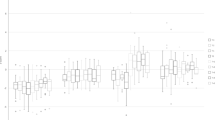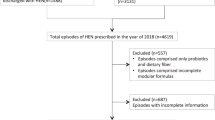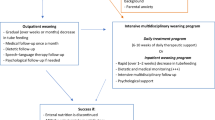Abstract
Background/Objectives:
The practice of home enteral nutrition (HEN) represents a relevant aspect of the clinical management of both malnourished children and well-nourished children unable to be fed using an oral diet. The aim of this study was to estimate in an Italian paediatric population over a 14-year period (1996–2009), the clinical relevance and results over time of HEN activity.
Subjects/methods:
HEN-computerized database and medical/dietetic charts were evaluated for patients aged at start of HEN <18 years and HEN duration >1 month.
Results:
During the study period, we recorded 757 HEN programs. HEN began at a median age of 2 years for a median duration of 8.1 months. The complication rate was 14.8%. In the second period of the survey (2003–2009), the main changes concerned the underlying diseases requiring HEN, choice of formula feeding and access route. In 2009, the estimated overall prevalence of HEN was 3.47 and the incidence 2.45 per 100 000 inhabitants from 0 to 18 years of age.
Conclusions:
The epidemiological data of this study demonstrate that HEN concerns a growing number of Italian children and families. Some aspects of HEN clinical management should be modified to reach the recommended standards.
This is a preview of subscription content, access via your institution
Access options
Subscribe to this journal
Receive 12 print issues and online access
$259.00 per year
only $21.58 per issue
Buy this article
- Purchase on Springer Link
- Instant access to full article PDF
Prices may be subject to local taxes which are calculated during checkout




Similar content being viewed by others
References
Braegger C, Decsi D, Dias JA, Hartman C, Kolacek S, Koletzko B et alESPGHAN Committee on nutrition. Practical approach to paediatric enteral nutrition: a comment by the ESPGHAN Committee on nutrition. J Pediatr Gastroenterol Nutr 2010; 51: 110–122.
Axelrod D, Kazmerski K, Iyer K . Pediatric enteral nutrition. J Parenter Enteral Nutr 2006; 30 (1 Suppl), S21–S26.
Elia M . An international perspective on artificial nutrition support in the community. Lancet 1995; 345: 1345–1349.
Pironi L, Candusso M, Biondo A, Bosco A, Castaldi P, Contaldo F et alItalian Society for Parenteral and Enteral Nutrition Executive Committee. Prevalence of home artificial nutrition in Italy in 2005: A survey by the Italian Society for Parenteral and Enteral Nutrition (SINPE). Clin Nutr 2007; 26: 123–132.
Daveluy W, Guimber D, Mention K, Lescut D, Michaud L, Turck D et al. Home enteral nutrition in children: an 11-year experience with 416 patients. Clin Nutr 2005; 24: 48–54.
Gómez-López L, Martínez-Costa C, Pedrón-Giner C, Calderón-Garrido C, Navas López VM, Martínez Zazo A et al. Current status of pediatric enteral nutrition in Spain: the importance of the NEPAD register. Nutr Hosp 2010; 25: 810–813.
Szlagatys-Sidorkiewicz A, Popińska K, Toporowska-Kowalska E, Borkowska A, Sibilska M, Gębora-Kowalska B et al. Home enteral nutrition in children—2010 nationwide survey of the Polish Society for Clinical Nutrition of Children. Eur J Pediatr 2012; 171: 719–723.
Daveluy W, Guimber D, Uhlen S, Lescut D, Michaud L, Turck D et al. Dramatic changes in home-based enteral nutrition practices in children during an 11-year period. J Pediatr Gastroenterol Nutr 2006; 43: 240–244.
National Institute of Statistics. Popolazione Residente e Abitazioni Nelle Province italiane. 14° Censimento Generale Della Popolazione e Delle Abitazioni. ISTAT: Rome, 2001.
National Institute of Statistics. Popolazione Comunale per sesso età e stato civile. Anni 2002–2005. ISTAT: Rome, 2006.
Howard L, Ament M, Fleming CR, Shike M, Steiger E . Current use and clinical outcome of home parenteral and enteral nutrition therapies in the United States. Gastroenterology 1995; 109: 355–365.
DeLegge M, Wooley JA, Guenter P, Wright S, Brill J, Andris D et alA.S.P.E.N. Practice Management Task Force; A.S.P.E.N. Board of Directors. The state of nutrition support teams and update on current models for providing nutrition support therapy to patients. Nutr Clin Pract 2010; 25: 76–84.
Klek S, Szybinski P, Sierzega M, Szczepanek K, Sumlet M, Kupiec M et al. Commercial enteral formulas and nutrition support teams improve the outcome of home enteral tube feeding. J Parenter Enteral Nutr 2011; 35: 380–385.
Paccagnella A, Baruffi C, Pizzolato D, Favaro V, Marcon ML, Morello M et al. Home enteral nutrition in adults: a five-year (2001-2005) epidemiological analysis. Clin Nutr 2008; 27: 378–385.
Buchman AL . Ethical and economics in nutrition support. In: Lochs H, Thomas DR, (eds.) Home Care Enteral Feeding. NestléNutrition Workshop Series Clinical & Performance Program. Nestlé Ltd vol. 10, Vevey/S. Karger AG: Basel, 2005 pp 143–166.
Cawsey SI, Soo J, Gramlich LM . Home enteral nutrition: outcomes relative to indication. Nutr Clin Pract 2010; 25: 296–300.
Cuerda C, Planas M, Gomez-Candela C, Luengo LM, NADYA-SENPE group. Trends in home enteral nutrition in Spain; analysis of the NADYA registry 1992-2007. Nutr Hosp 2009; 24: 347–353.
Song J, Wolf SE, Wu X, Finnerty CC, Gauglitz GG, Herndon DN et al. Starvation-induced proximal gut mucosal atrophy diminished with aging. J Parenter Enteral Nutr 2009; 33: 411–416.
Chappel VL, Thopson MD, Jeschke MG, Chung DH, Thompson JC, Wolf SE . Effects of incremental starvation on gut mucosa. Dig Dis Sci 2003; 48: 765–769.
Zachos M, Tondeur M, Griffiths AM . Enteral nutrition therapy for induction of remission in Crohn’s disease. Cochrane Database Syst Rev 2007 (1): CD000542.
Acknowledgements
We thank Maddalena Grisoni, nurse coordinator of the nutritional team of the ‘Bambino Gesù’ Children’s Hospital, for her relevant help in collecting the data.
Author information
Authors and Affiliations
Consortia
Corresponding author
Ethics declarations
Competing interests
The authors declare no conflict of interest.
Rights and permissions
About this article
Cite this article
Diamanti, A., Di Ciommo, V., Tentolini, A. et al. Home enteral nutrition in children: a 14-year multicenter survey. Eur J Clin Nutr 67, 53–57 (2013). https://doi.org/10.1038/ejcn.2012.184
Received:
Revised:
Accepted:
Published:
Issue Date:
DOI: https://doi.org/10.1038/ejcn.2012.184
Keywords
This article is cited by
-
Enteral Tube Feeding in Paediatric Mitochondrial Diseases
Scientific Reports (2017)
-
Diagnosis of gastroesophageal reflux and anti-reflux procedures among polish children with gastrostomies: a 10-year nationwide analysis
European Journal of Clinical Nutrition (2013)



